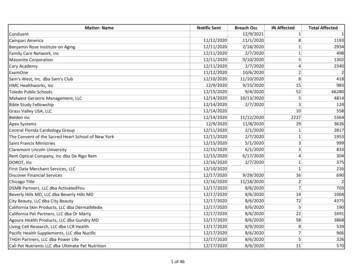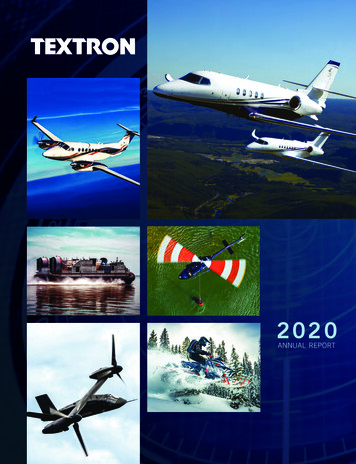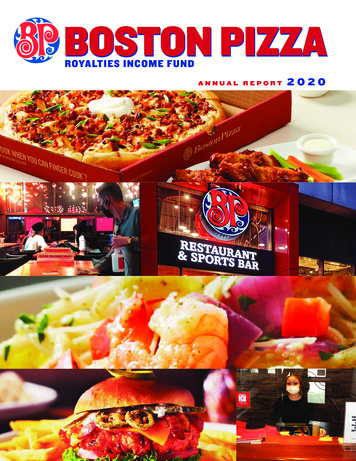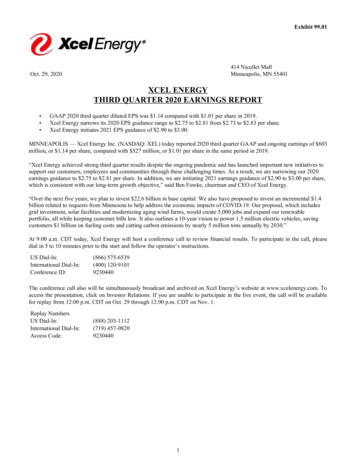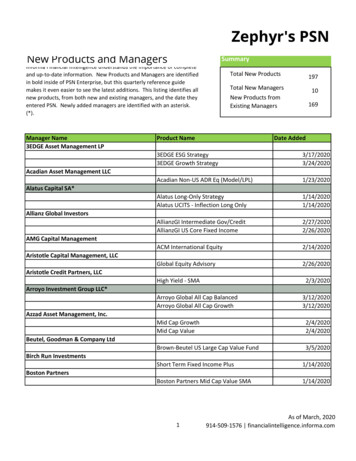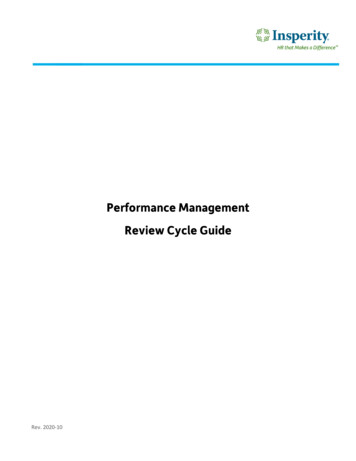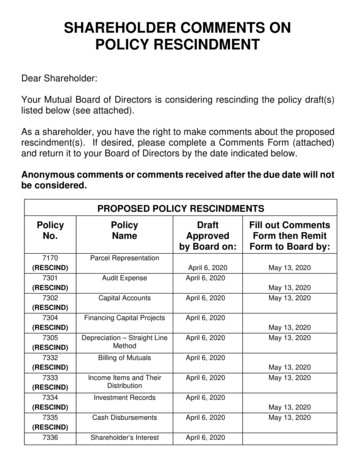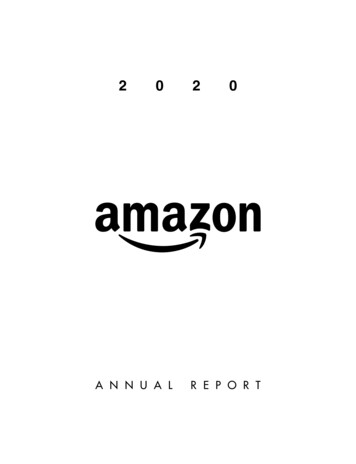
Transcription
20A N N U A L20R E P O R T
To our shareowners:In Amazon’s 1997 letter to shareholders, our first, I talked about our hope to create an “enduring franchise,”one that would reinvent what it means to serve customers by unlocking the internet’s power. I noted thatAmazon had grown from having 158 employees to 614, and that we had surpassed 1.5 million customeraccounts. We had just gone public at a split-adjusted stock price of 1.50 per share. I wrote that it was Day 1.We’ve come a long way since then, and we are working harder than ever to serve and delight customers.Last year, we hired 500,000 employees and now directly employ 1.3 million people around the world. We havemore than 200 million Prime members worldwide. More than 1.9 million small and medium-sized businessessell in our store, and they make up close to 60% of our retail sales. Customers have connected more than100 million smart home devices to Alexa. Amazon Web Services serves millions of customers and ended 2020with a 50 billion annualized run rate. In 1997, we hadn’t invented Prime, Marketplace, Alexa, or AWS.They weren’t even ideas then, and none was preordained. We took great risk with each one and put sweatand ingenuity into each one.Along the way, we’ve created 1.6 trillion of wealth for shareowners. Who are they? Your Chair is one, andmy Amazon shares have made me wealthy. But more than 7/8ths of the shares, representing 1.4 trillion ofwealth creation, are owned by others. Who are they? They’re pension funds, universities, and 401(k)s, andthey’re Mary and Larry, who sent me this note out of the blue just as I was sitting down to write thisshareholder letter:
I am approached with similar stories all the time. I know people who’ve used their Amazon money forcollege, for emergencies, for houses, for vacations, to start their own business, for charity – and the list goeson. I’m proud of the wealth we’ve created for shareowners. It’s significant, and it improves their lives. But Ialso know something else: it’s not the largest part of the value we’ve created.Create More Than You ConsumeIf you want to be successful in business (in life, actually), you have to create more than you consume. Yourgoal should be to create value for everyone you interact with. Any business that doesn’t create value for thoseit touches, even if it appears successful on the surface, isn’t long for this world. It’s on the way out.Remember that stock prices are not about the past. They are a prediction of future cash flows discountedback to the present. The stock market anticipates. I’m going to switch gears for a moment and talk about thepast. How much value did we create for shareowners in 2020? This is a relatively easy question to answerbecause accounting systems are set up to answer it. Our net income in 2020 was 21.3 billion. If, instead ofbeing a publicly traded company with thousands of owners, Amazon were a sole proprietorship with a singleowner, that’s how much the owner would have earned in 2020.How about employees? This is also a reasonably easy value creation question to answer because we can lookat compensation expense. What is an expense for a company is income for employees. In 2020, employeesearned 80 billion, plus another 11 billion to include benefits and various payroll taxes, for a total of 91 billion.How about third-party sellers? We have an internal team (the Selling Partner Services team) that works toanswer that question. They estimate that, in 2020, third-party seller profits from selling on Amazon werebetween 25 billion and 39 billion, and to be conservative here I’ll go with 25 billion.For customers, we have to break it down into consumer customers and AWS customers.We’ll do consumers first. We offer low prices, vast selection, and fast delivery, but imagine we ignore all ofthat for the purpose of this estimate and value only one thing: we save customers time.Customers complete 28% of purchases on Amazon in three minutes or less, and half of all purchases arefinished in less than 15 minutes. Compare that to the typical shopping trip to a physical store – driving,parking, searching store aisles, waiting in the checkout line, finding your car, and driving home. Researchsuggests the typical physical store trip takes about an hour. If you assume that a typical Amazon purchasetakes 15 minutes and that it saves you a couple of trips to a physical store a week, that’s more than 75hours a year saved. That’s important. We’re all busy in the early 21st century.So that we can get a dollar figure, let’s value the time savings at 10 per hour, which is conservative. Seventyfive hours multiplied by 10 an hour and subtracting the cost of Prime gives you value creation for eachPrime member of about 630. We have 200 million Prime members, for a total in 2020 of 126 billion of valuecreation.AWS is challenging to estimate because each customer’s workload is so different, but we’ll do it anyway,acknowledging up front that the error bars are high. Direct cost improvements from operating in the cloudversus on premises vary, but a reasonable estimate is 30%. Across AWS’s entire 2020 revenue of 45 billion,that 30% would imply customer value creation of 19 billion (what would have cost them 64 billion ontheir own cost 45 billion from AWS). The difficult part of this estimation exercise is that the direct costreduction is the smallest portion of the customer benefit of moving to the cloud. The bigger benefit is theincreased speed of software development – something that can significantly improve the customer’scompetitiveness and top line. We have no reasonable way of estimating that portion of customer valueexcept to say that it’s almost certainly larger than the direct cost savings. To be conservative here (andremembering we’re really only trying to get ballpark estimates), I’ll say it’s the same and call AWS customervalue creation 38 billion in 2020.Adding AWS and consumer together gives us total customer value creation in 2020 of 164 billion.
Summarizing:ShareholdersEmployees3P SellersCustomersTotal 21B 91B 25B 164B 301BIf each group had an income statement representing their interactions with Amazon, the numbers abovewould be the “bottom lines” from those income statements. These numbers are part of the reason why peoplework for us, why sellers sell through us, and why customers buy from us. We create value for them. Andthis value creation is not a zero-sum game. It is not just moving money from one pocket to another. Drawthe box big around all of society, and you’ll find that invention is the root of all real value creation. And valuecreated is best thought of as a metric for innovation.Of course, our relationship with these constituencies and the value we create isn’t exclusively dollars andcents. Money doesn’t tell the whole story. Our relationship with shareholders, for example, is relatively simple.They invest and hold shares for a duration of their choosing. We provide direction to shareownersinfrequently on matters such as annual meetings and the right process to vote their shares. And even thenthey can ignore those directions and just skip voting.Our relationship with employees is a very different example. We have processes they follow and standardsthey meet. We require training and various certifications. Employees have to show up at appointed times. Ourinteractions with employees are many, and they’re fine-grained. It’s not just about the pay and the benefits.It’s about all the other detailed aspects of the relationship too.Does your Chair take comfort in the outcome of the recent union vote in Bessemer? No, he doesn’t. I thinkwe need to do a better job for our employees. While the voting results were lopsided and our directrelationship with employees is strong, it’s clear to me that we need a better vision for how we create value foremployees – a vision for their success.If you read some of the news reports, you might think we have no care for employees. In those reports, ouremployees are sometimes accused of being desperate souls and treated as robots. That’s not accurate. They’resophisticated and thoughtful people who have options for where to work. When we survey fulfillmentcenter employees, 94% say they would recommend Amazon to a friend as a place to work.Employees are able to take informal breaks throughout their shifts to stretch, get water, use the rest room,or talk to a manager, all without impacting their performance. These informal work breaks are in addition tothe 30-minute lunch and 30-minute break built into their normal schedule.We don’t set unreasonable performance goals. We set achievable performance goals that take into accounttenure and actual employee performance data. Performance is evaluated over a long period of time as weknow that a variety of things can impact performance in any given week, day, or hour. If employees are ontrack to miss a performance target over a period of time, their manager talks with them and providescoaching.Coaching is also extended to employees who are excelling and in line for increased responsibilities. In fact,82% of coaching is positive, provided to employees who are meeting or exceeding expectations. We terminatethe employment of less than 2.6% of employees due to their inability to perform their jobs (and thatnumber was even lower in 2020 because of operational impacts of COVID-19).Earth’s Best Employer and Earth’s Safest Place to WorkThe fact is, the large team of thousands of people who lead operations at Amazon have always cared deeplyfor our hourly employees, and we’re proud of the work environment we’ve created. We’re also proud of thefact that Amazon is a company that does more than just create jobs for computer scientists and people withadvanced degrees. We create jobs for people who never got that advantage.
Despite what we’ve accomplished, it’s clear to me that we need a better vision for our employees’ success.We have always wanted to be Earth’s Most Customer-Centric Company. We won’t change that. It’s what gotus here. But I am committing us to an addition. We are going to be Earth’s Best Employer and Earth’sSafest Place to Work.In my upcoming role as Executive Chair, I’m going to focus on new initiatives. I’m an inventor. It’s what Ienjoy the most and what I do best. It’s where I create the most value. I’m excited to work alongside the largeteam of passionate people we have in Ops and help invent in this arena of Earth’s Best Employer andEarth’s Safest Place to Work. On the details, we at Amazon are always flexible, but on matters of vision weare stubborn and relentless. We have never failed when we set our minds to something, and we’re not going tofail at this either.We dive deep into safety issues. For example, about 40% of work-related injuries at Amazon are related tomusculoskeletal disorders (MSDs), things like sprains or strains that can be caused by repetitive motions.MSDs are common in the type of work that we do and are more likely to occur during an employee’s firstsix months. We need to invent solutions to reduce MSDs for new employees, many of whom might beworking in a physical role for the first time.One such program is WorkingWell – which we launched to 859,000 employees at 350 sites across NorthAmerica and Europe in 2020 – where we coach small groups of employees on body mechanics, proactivewellness, and safety. In addition to reducing workplace injuries, these concepts have a positive impact onregular day-to-day activities outside work.We’re developing new automated staffing schedules that use sophisticated algorithms to rotate employeesamong jobs that use different muscle-tendon groups to decrease repetitive motion and help protect employeesfrom MSD risks. This new technology is central to a job rotation program that we’re rolling out throughout2021.Our increased attention to early MSD prevention is already achieving results. From 2019 to 2020, overallMSDs decreased by 32%, and MSDs resulting in time away from work decreased by more than half.We employ 6,200 safety professionals at Amazon. They use the science of safety to solve complex problemsand establish new industry best practices. In 2021, we’ll invest more than 300 million into safety projects,including an initial 66 million to create technology that will help prevent collisions of forklifts and othertypes of industrial vehicles.When we lead, others follow. Two and a half years ago, when we set a 15 minimum wage for our hourlyemployees, we did so because we wanted to lead on wages – not just run with the pack – and because webelieved it was the right thing to do. A recent paper by economists at the University of California-Berkeleyand Brandeis University analyzed the impact of our decision to raise our minimum starting pay to 15 perhour. Their assessment reflects what we’ve heard from employees, their families, and the communities theylive in.Our increase in starting wage boosted local economies across the country by benefiting not only our ownemployees but also other workers in the same community. The study showed that our pay raise resulted in a4.7% increase in the average hourly wage among other employers in the same labor market.And we’re not done leading. If we want to be Earth’s Best Employer, we shouldn’t settle for 94% ofemployees saying they would recommend Amazon to a friend as a place to work. We have to aim for 100%.And we’ll do that by continuing to lead on wages, on benefits, on upskilling opportunities, and in otherways that we will figure out over time.If any shareowners are concerned that Earth’s Best Employer and Earth’s Safest Place to Work might diluteour focus on Earth’s Most Customer-Centric Company, let me set your mind at ease. Think of it this way.If we can operate two businesses as different as consumer ecommerce and AWS, and do both at the highestlevel, we can certainly do the same with these two vision statements. In fact, I’m confident they willreinforce each other.
The Climate PledgeIn an earlier draft of this letter, I started this section with arguments and examples designed to demonstratethat human-induced climate change is real. But, bluntly, I think we can stop saying that now. You don’thave to say that photosynthesis is real, or make the case that gravity is real, or that water boils at 100 degreesCelsius at sea level. These things are simply true, as is the reality of climate change.Not long ago, most people believed that it would be good to address climate change, but they also thoughtit would cost a lot and would threaten jobs, competitiveness, and economic growth. We now know better.Smart action on climate change will not only stop bad things from happening, it will also make oureconomy more efficient, help drive technological change, and reduce risks. Combined, these can lead tomore and better jobs, healthier and happier children, more productive workers, and a more prosperous future.This doesn’t mean it will be easy. It won’t be. The coming decade will be decisive. The economy in 2030 willneed to be vastly different from what it is today, and Amazon plans to be at the heart of the change. Welaunched The Climate Pledge together with Global Optimism in September 2019 because we wanted tohelp drive this positive revolution. We need to be part of a growing team of corporations that understandthe imperatives and the opportunities of the 21st century.Now, less than two years later, 53 companies representing almost every sector of the economy have signedThe Climate Pledge. Signatories such as Best Buy, IBM, Infosys, Mercedes-Benz, Microsoft, Siemens, andVerizon have committed to achieve net-zero carbon in their worldwide businesses by 2040, 10 years ahead ofthe Paris Agreement. The Pledge also requires them to measure and report greenhouse gas emissions on aregular basis; implement decarbonization strategies through real business changes and innovations; andneutralize any remaining emissions with additional, quantifiable, real, permanent, and socially beneficialoffsets. Credible, quality offsets are precious, and we should reserve them to compensate for economicactivities where low-carbon alternatives don’t exist.The Climate Pledge signatories are making meaningful, tangible, and ambitious commitments. Uber has agoal of operating as a zero-emission platform in Canada, Europe, and the U.S. by 2030, and Henkel plans tosource 100% of the electricity it uses for production from renewable sources. Amazon is making progresstoward our own goal of 100% renewable energy by 2025, five years ahead of our initial 2030 target. Amazonis the largest corporate buyer of renewable energy in the world. We have 62 utility-scale wind and solarprojects and 125 solar rooftops on fulfillment and sort centers around the globe. These projects have thecapacity to generate over 6.9 gigawatts and deliver more than 20 million megawatt-hours of energy annually.Transportation is a major component of Amazon’s business operations and the toughest part of our planto meet net-zero carbon by 2040. To help rapidly accelerate the market for electric vehicle technology, and tohelp all companies transition to greener technologies, we invested more than 1 billion in Rivian – andordered 100,000 electric delivery vans from the company. We’ve also partnered with Mahindra in India andMercedes-Benz in Europe. These custom electric delivery vehicles from Rivian are already operational, andthey first hit the road in Los Angeles this past February. Ten thousand new vehicles will be on the road asearly as next year, and all 100,000 vehicles will be on the road by 2030 – saving millions of metric tons ofcarbon. A big reason we want companies to join The Climate Pledge is to signal to the marketplace thatbusinesses should start inventing and developing new technologies that signatories need to make good onthe Pledge. Our purchase of 100,000 Rivian electric vans is a perfect example.To further accelerate investment in new technologies needed to build a zero-carbon economy, we introducedthe Climate Pledge Fund last June. The investment program started with 2 billion to invest in visionarycompanies that aim to facilitate the transition to a low-carbon economy. Amazon has already announcedinvestments in CarbonCure Technologies, Pachama, Redwood Materials, Rivian, Turntide Technologies,ZeroAvia, and Infinium – and these are just some of the innovative companies we hope will build the zerocarbon economy of the future.I have also personally allocated 10 billion to provide grants to help catalyze the systemic change we willneed in the coming decade. We’ll be supporting leading scientists, activists, NGOs, environmental justiceorganizations, and others working to fight climate change and protect the natural world. Late last year, I mademy first round of grants to 16 organizations working on innovative and needle-moving solutions. It’s going
to take collective action from big companies, small companies, nation states, global organizations, andindividuals, and I’m excited to be part of this journey and optimistic that humanity can come together tosolve this challenge.Differentiation is Survival and the Universe Wants You to be TypicalThis is my last annual shareholder letter as the CEO of Amazon, and I have one last thing of utmostimportance I feel compelled to teach. I hope all Amazonians take it to heart.Here is a passage from Richard Dawkins’ (extraordinary) book The Blind Watchmaker. It’s about a basicfact of biology.“Staving off death is a thing that you have to work at. Left to itself – and that is what it is when itdies – the body tends to revert to a state of equilibrium with its environment. If you measure somequantity such as the temperature, the acidity, the water content or the electrical potential in a livingbody, you will typically find that it is markedly different from the corresponding measure in thesurroundings. Our bodies, for instance, are usually hotter than our surroundings, and in cold climatesthey have to work hard to maintain the differential. When we die the work stops, the temperaturedifferential starts to disappear, and we end up the same temperature as our surroundings. Not allanimals work so hard to avoid coming into equilibrium with their surrounding temperature, but allanimals do some comparable work. For instance, in a dry country, animals and plants work tomaintain the fluid content of their cells, work against a natural tendency for water to flow from theminto the dry outside world. If they fail they die. More generally, if living things didn’t work actively toprevent it, they would eventually merge into their surroundings, and cease to exist as autonomousbeings. That is what happens when they die.”While the passage is not intended as a metaphor, it’s nevertheless a fantastic one, and very relevant toAmazon. I would argue that it’s relevant to all companies and all institutions and to each of our individuallives too. In what ways does the world pull at you in an attempt to make you normal? How much work does ittake to maintain your distinctiveness? To keep alive the thing or things that make you special?I know a happily married couple who have a running joke in their relationship. Not infrequently, thehusband looks at the wife with faux distress and says to her, “Can’t you just be normal?” They both smileand laugh, and of course the deep truth is that her distinctiveness is something he loves about her. But, at thesame time, it’s also true that things would often be easier – take less energy – if we were a little morenormal.This phenomenon happens at all scale levels. Democracies are not normal. Tyranny is the historical norm. Ifwe stopped doing all of the continuous hard work that is needed to maintain our distinctiveness in thatregard, we would quickly come into equilibrium with tyranny.We all know that distinctiveness – originality – is valuable. We are all taught to “be yourself.” What I’mreally asking you to do is to embrace and be realistic about how much energy it takes to maintain thatdistinctiveness. The world wants you to be typical – in a thousand ways, it pulls at you. Don’t let it happen.You have to pay a price for your distinctiveness, and it’s worth it. The fairy tale version of “be yourself ” is thatall the pain stops as soon as you allow your distinctiveness to shine. That version is misleading. Beingyourself is worth it, but don’t expect it to be easy or free. You’ll have to put energy into it continuously.The world will always try to make Amazon more typical – to bring us into equilibrium with our environment.It will take continuous effort, but we can and must be better than that.***As always, I attach our 1997 shareholder letter. It concluded with this: “We at Amazon.com are grateful toour customers for their business and trust, to each other for our hard work, and to our shareholders for theirsupport and encouragement.” That hasn’t changed a bit. I want to especially thank Andy Jassy for agreeingto take on the CEO role. It’s a hard job with a lot of responsibility. Andy is brilliant and has the highest
of high standards. I guarantee you that Andy won’t let the universe make us typical. He will muster theenergy needed to keep alive in us what makes us special. That won’t be easy, but it is critical. I also predict itwill be satisfying and oftentimes fun. Thank you, Andy.To all of you: be kind, be original, create more than you consume, and never, never, never let the universesmooth you into your surroundings. It remains Day 1.Sincerely,Jeffrey P. BezosFounder and Chief Executive OfficerAmazon.com, Inc.
1997 LETTER TO SHAREHOLDERS(Reprinted from the 1997 Annual Report)To our shareholders:Amazon.com passed many milestones in 1997: by year-end, we had served more than 1.5 million customers,yielding 838% revenue growth to 147.8 million, and extended our market leadership despite aggressivecompetitive entry.But this is Day 1 for the Internet and, if we execute well, for Amazon.com. Today, online commerce savescustomers money and precious time. Tomorrow, through personalization, online commerce will accelerate thevery process of discovery. Amazon.com uses the Internet to create real value for its customers and, by doing so,hopes to create an enduring franchise, even in established and large markets.We have a window of opportunity as larger players marshal the resources to pursue the online opportunityand as customers, new to purchasing online, are receptive to forming new relationships. The competitivelandscape has continued to evolve at a fast pace. Many large players have moved online with credible offeringsand have devoted substantial energy and resources to building awareness, traffic, and sales. Our goal is to movequickly to solidify and extend our current position while we begin to pursue the online commerce opportunitiesin other areas. We see substantial opportunity in the large markets we are targeting. This strategy is not withoutrisk: it requires serious investment and crisp execution against established franchise leaders.It’s All About the Long TermWe believe that a fundamental measure of our success will be the shareholder value we create over the longterm. This value will be a direct result of our ability to extend and solidify our current market leadership position.The stronger our market leadership, the more powerful our economic model. Market leadership can translatedirectly to higher revenue, higher profitability, greater capital velocity, and correspondingly stronger returns oninvested capital.Our decisions have consistently reflected this focus. We first measure ourselves in terms of the metrics mostindicative of our market leadership: customer and revenue growth, the degree to which our customers continue topurchase from us on a repeat basis, and the strength of our brand. We have invested and will continue to investaggressively to expand and leverage our customer base, brand, and infrastructure as we move to establish anenduring franchise.Because of our emphasis on the long term, we may make decisions and weigh tradeoffs differently thansome companies. Accordingly, we want to share with you our fundamental management and decision-makingapproach so that you, our shareholders, may confirm that it is consistent with your investment philosophy: We will continue to focus relentlessly on our customers. We will continue to make investment decisions in light of long-term market leadership considerationsrather than short-term profitability considerations or short-term Wall Street reactions. We will continue to measure our programs and the effectiveness of our investments analytically, tojettison those that do not provide acceptable returns, and to step up our investment in those that workbest. We will continue to learn from both our successes and our failures.
We will make bold rather than timid investment decisions where we see a sufficient probability ofgaining market leadership advantages. Some of these investments will pay off, others will not, and wewill have learned another valuable lesson in either case. When forced to choose between optimizing the appearance of our GAAP accounting and maximizingthe present value of future cash flows, we’ll take the cash flows. We will share our strategic thought processes with you when we make bold choices (to the extentcompetitive pressures allow), so that you may evaluate for yourselves whether we are making rationallong-term leadership investments. We will work hard to spend wisely and maintain our lean culture. We understand the importance ofcontinually reinforcing a cost-conscious culture, particularly in a business incurring net losses. We will balance our focus on growth with emphasis on long-term profitability and capital management.At this stage, we choose to prioritize growth because we believe that scale is central to achieving thepotential of our business model. We will continue to focus on hiring and retaining versatile and talented employees, and continue toweight their compensation to stock options rather than cash. We know our success will be largelyaffected by our ability to attract and retain a motivated employee base, each of whom must think like,and therefore must actually be, an owner.We aren’t so bold as to claim that the above is the “right” investment philosophy, but it’s ours, and wewould be remiss if we weren’t clear in the approach we have taken and will continue to take.With this foundation, we would like to turn to a review of our business focus, our progress in 1997, and ouroutlook for the future.Obsess Over CustomersFrom the beginning, our focus has been on offering our customers compelling value. We realized that theWeb was, and still is, the World Wide Wait. Therefore, we set out to offer customers something they simplycould not get any other way, and began serving them with books. We brought them much more selection thanwas possible in a physical store (our store would now occupy 6 football fields), and presented it in a useful, easyto-search, and easy-to-browse format in a store open 365 days a year, 24 hours a day. We maintained a doggedfocus on improving the shopping experience, and in 1997 substantially enhanced our store. We now offercustomers gift certificates, 1-ClickSM shopping, and vastly more reviews, content, browsing options, andrecommendation features. We dramatically lowered prices, further increasing customer value. Word of mouthremains the most powerful customer acquisition tool we have, and we are grateful for the trust our customershave placed in us. Repeat purchases and word of mouth have combined to make Amazon.com the market leaderin online bookselling.By many measures, Amazon.com came a long way in 1997: Sales grew from 15.7 million in 1996 to 147.8 million – an 838% increase. Cumulative customer accounts grew from 180,000 to 1,510,000 – a 738% increase. The percentage of orders from repeat customers grew from over 46% in the fou
that 30% would imply customer value creation of 19 billion (what would have cost them 64 billion on their own cost 45 billion from AWS). The difficult part of this estimation exercise is that the direct cost reduction is the smallest portion of the customer benefit of moving to the cloud. The bigger benefit is the



